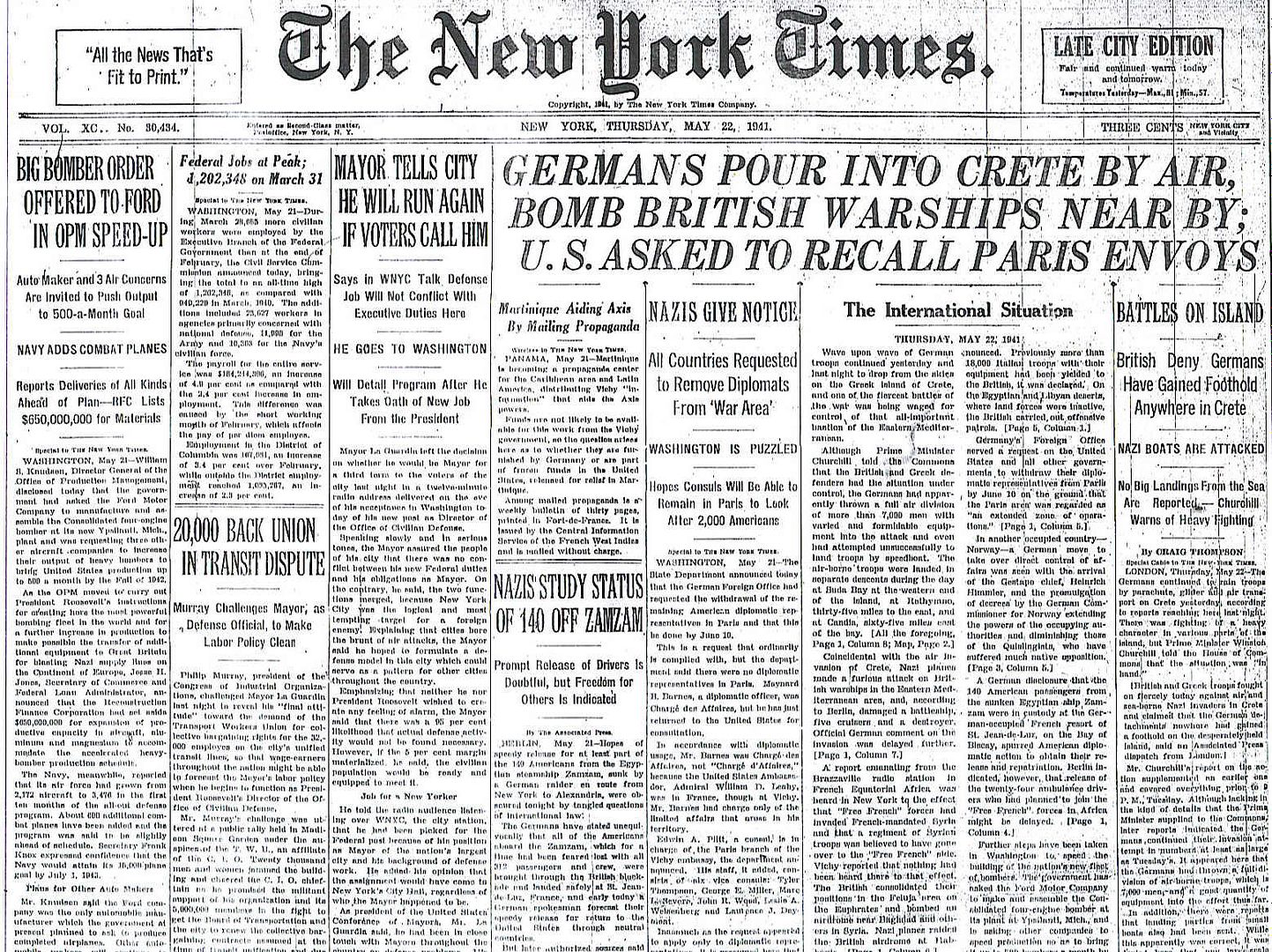
Posted on 05/22/2011 5:58:15 AM PDT by Homer_J_Simpson

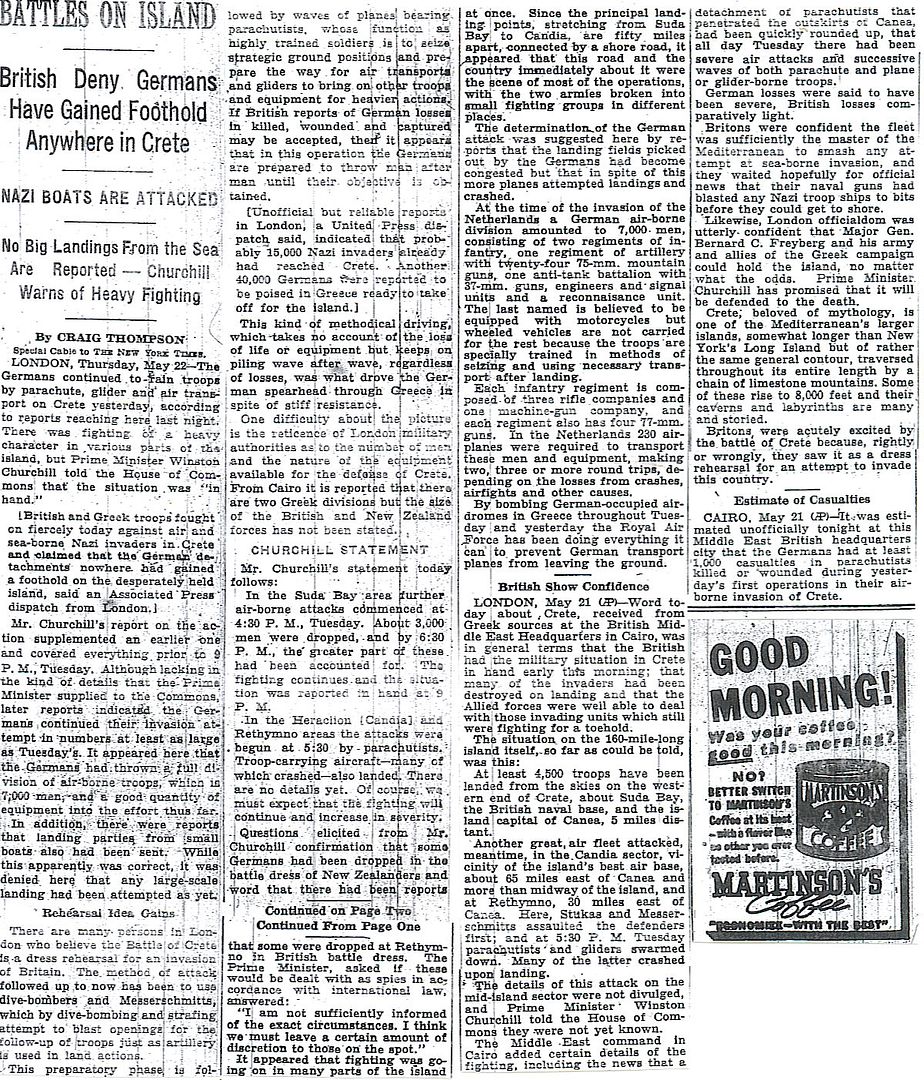

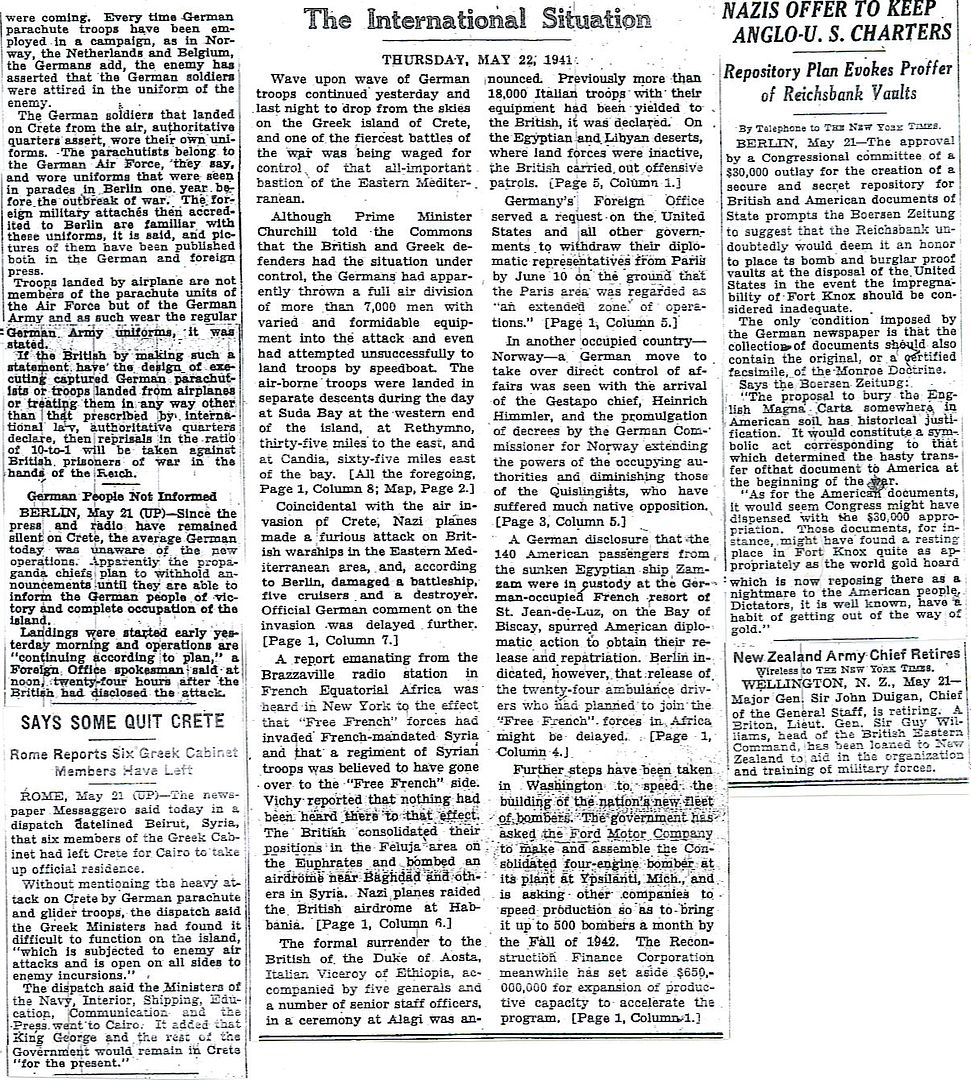
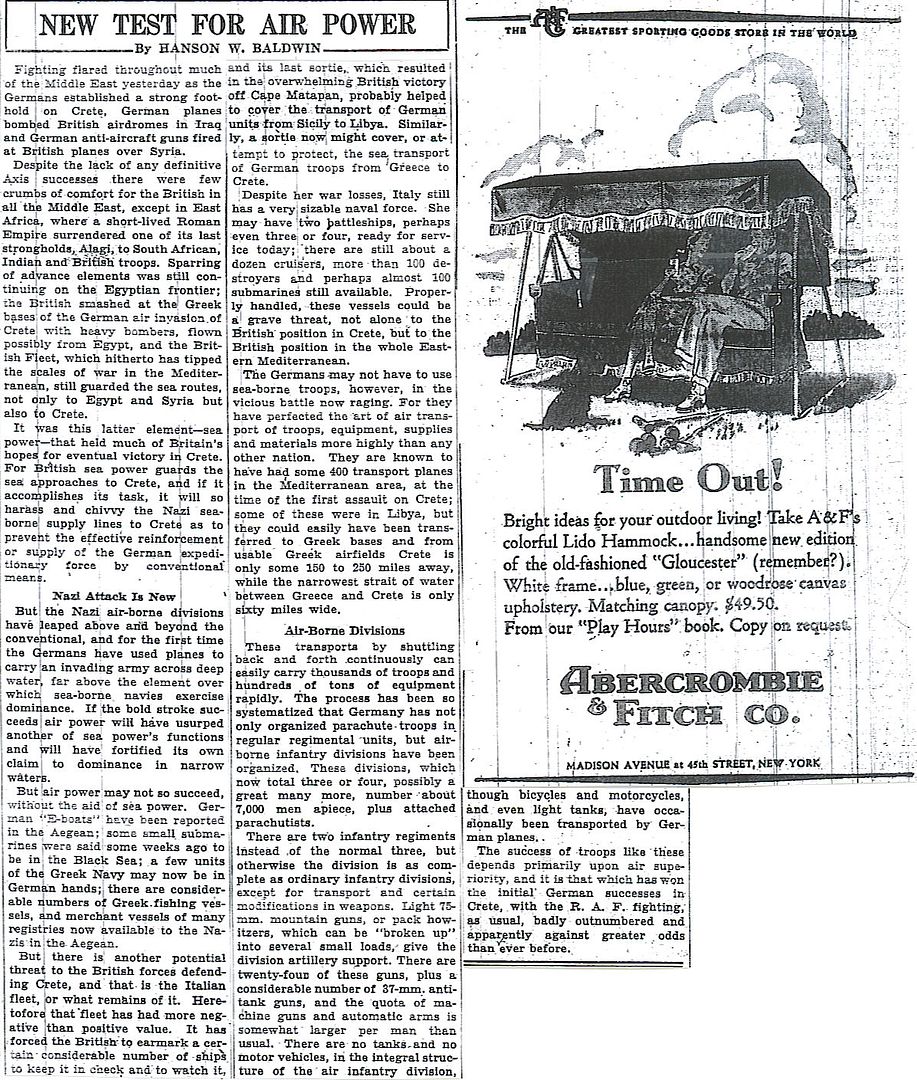
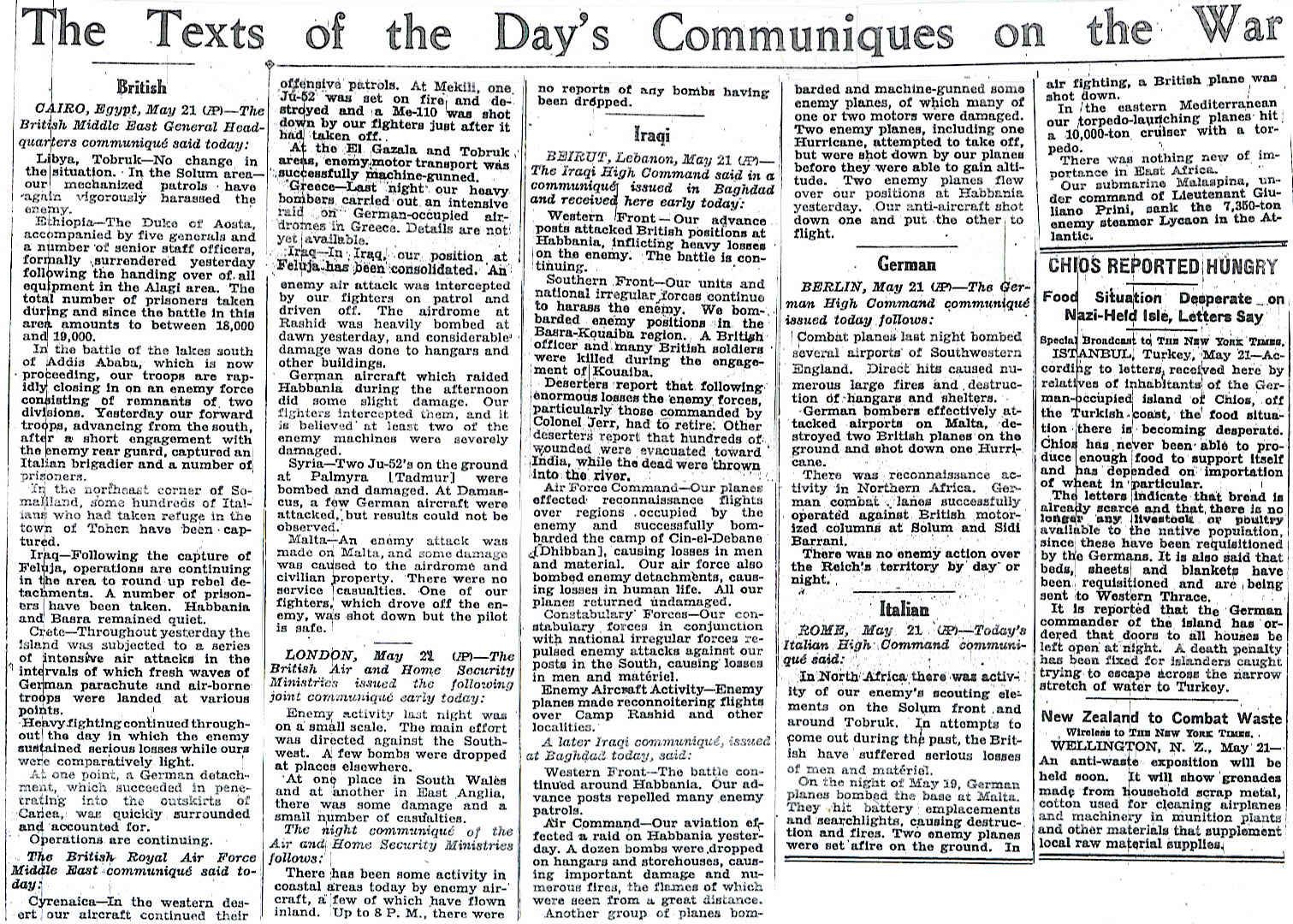

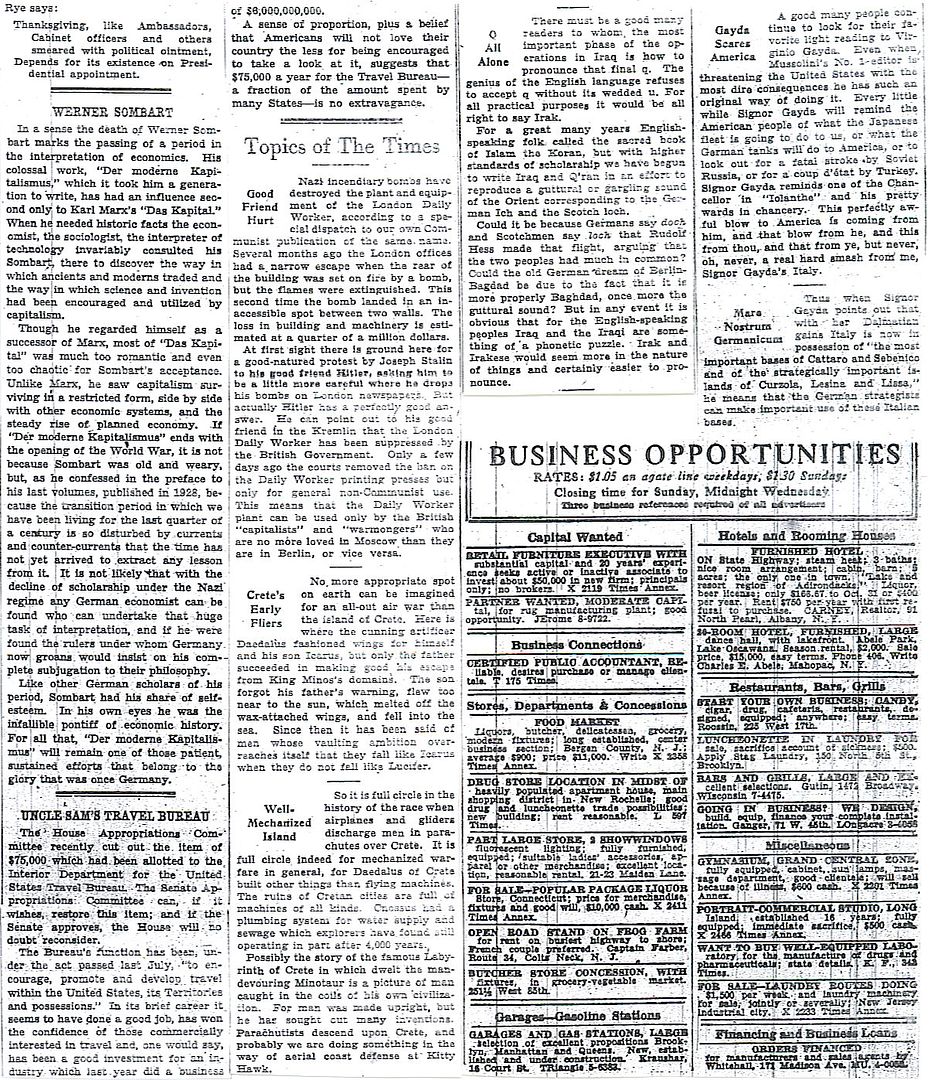
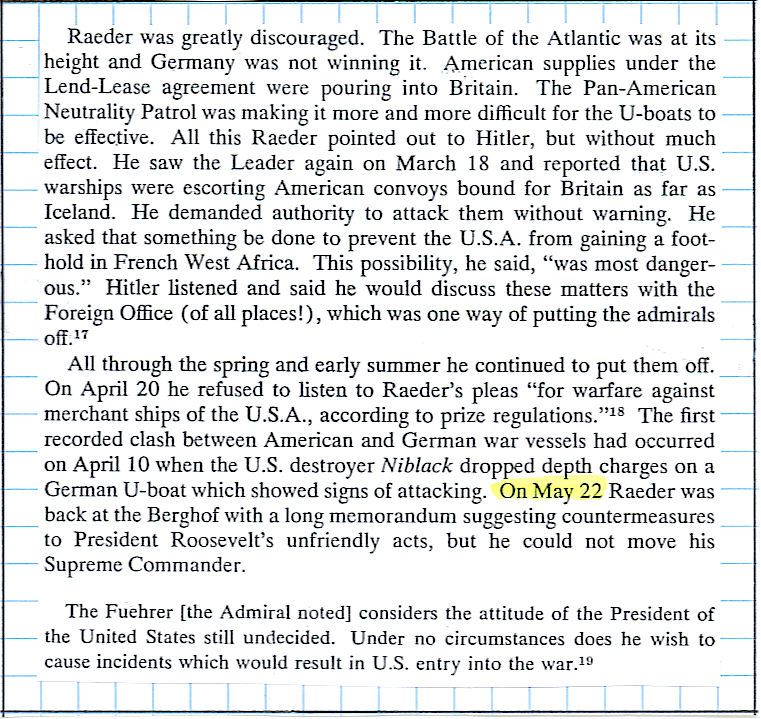
William L. Shirer, The Rise and Fall of the Third Reich
Editorials
The Invasion of Crete
Troops by Glider
Railway Wage Demand
WPA vs. Defense
China Week
Thanksgiving Day Restored
Werner Sombart
Uncle Sam’s Travel Bureau
Topics of the Times
http://www.hmshood.com/history/timeline4.htm
22–24 May: (HMS Hood) At sea with the battleship Prince of Wales, and destroyers Acates, Antelope, Anthony, Echo, Electra and Icarus. The force proceeded to waters off southern Iceland in case Bismarck and the accompanying cruiser Prinz Eugen attempted a breakout into the Atlantic in that vicinity.
http://www.onwar.com/chrono/1941/may41/f22may41.htm
British retreating on Crete
Thursday, May 22, 1941 www.onwar.com
In the Mediterranean... On Crete, in the face of the growing strength and complete German air superiority, the British commander Freyberg cancels a counterattack against Maleme for the night of May 22-23rd and orders a withdrawal instead. A second German convoy is turned back but is not pursued far because the Luftwaffe intervenes. In various actions during the day the battleship Warspite is badly damaged and two cruisers and one destroyer are sunk. Admiral Cunningham, ashore in Alexandria, orders the fleet to return after being wrongly informed that ammunition for the battleship’s antiaircraft guns is in very short supply. During the night of May 22-23rd the Maleme airfield is bombarded by Lord Mountbatten’s 5th Destroyer Flotilla. King George of Greece is evacuated from the island to Egypt during the night.
In the North Atlantic... British planes report correctly that the German ships Bismark and Prinz Eugen have also put to sea and the Commander in Chief of the British Home Fleet, Admiral Tovey, therefore, sets out with the battleship King George V and the carrier Victorious. The battle cruiser Repulse joins this force later in the day. Tovey plans to reinforce the patrols watching the Faeroes-Iceland passage while Holland in the Hood goes to give further strength to the forces in the Denmark Strait.


Hood Enroute to Meet Bismarck, 22 May 1941
This photo was taken by a British aircraft southwest of the Faeroe Islands on the afternoon of 22 May 1941. Hood is shown on her very last mission, her ill-fated sortie to intercept the German battleship Bismarck. This is one of the two last clear photos taken of Hood. This photo kindly provided to the website by Douglas Wales-Smith.
http://www.kbismarck.com/histoperi.html
CAREER TIMELINE OF THE BISMARCK
22 May 1941 (Thursday):
0420. Course 0º. The destroyers leave the group. Bismarck takes the lead.
1200. Position 65º 53’ North, 03º 38’ East. Course 0º. Speed 24 knots.
1237-1307. U-boat and air alarm. Zig-zagging.
1310. Approximate course 325º
1800. New course 311º.
2125. Approximate course 295º.
2322. Course 266º.
http://homepage.ntlworld.com/andrew.etherington/month/thismonth/22.htm
May 22nd, 1941
UNITED KINGDOM: London: The Reuters News Agency reported:
Reports this morning state that violent struggles took place on Crete on Wednesday and that often the opposing troops were locked in hand-to-hand fighting. The battle also extended to the mountains and the tableland.
Minelayer HNLMS Nautilus sunk due to a collision with the British merchantman Murrayfield at 0023 near Saltfleet in position 53.36N, 00.25E. There were no fatalities.
Destroyer HMCS Saguenay completed refit Barrow-in-Furness. (Dave Shirlaw)
GERMANY: Kesselring moves the headquarters of his air fleet east to Posen.
U-373, U-571 commissioned. (Dave Shirlaw)
BALTIC SEA: U-564 rescued four crewmembers from a crashed JU 88 off Gotenhafen. (Dave Shirlaw)
U.S.S.R.: Soviet destroyer Razjarennyj launched. (Dave Shirlaw)
GREECE: CRETE: A force of four cruisers and three destroyers from the British Mediterranean Fleet are spotted to the north of the island. They are attacked by Ju87s of St.G 2 and later by Do 17s of KG 2 and Ju88s from Hptm Cuno Hoffman’s I./LG 1 from Eleusis. The cruisers HMS Naiad and HMS Carlisle are damaged, and shortly afterwards the battleship HMS Warspite receives a direct hit. Three and a half hours later the destroyer HMS Greyhound is caught on her own in the same area west of Crete and is soon sent to the bottom when she is hit by two bombs. The cruiser HMS Gloucester, going to pick up Greyhound’s survivors is rendered dead in the water by heavy aircraft attack west of Crete at 35 50N, 23 00E and is sunk by bombs from St.G 2 and I. and II./LG 1. Three hours later cruiser HMS Fiji is caught by a single Me109 fighter-bomber which reduces her speed to 17 knots and a heavy list. Then she takes three hits above the A boiler room and is rendered dead in the water. With no ammunition left on board she finally rolls over and sinks south of Crete at 34 35N, 23 10E. There are 248 casualties, but HMS Kingston and HMS KANDAHAR return after dark and rescue 523 officers and men, amongst them Stoker Walter Arnold who had survived the sinking of HMS Thetis. All ships are very short of AA ammunition by this time. (Alex Gordon)(108)
ZG 26’s Bf 110s, based at Argos, in company with Bf109s from I.(J)/LG 2 and II. and III./JG 77 escort the bombers and dive-bombers of VIII Fliegerkorps.
In turn the British naval forces encounter a convoy of German coastal motor sailers that had left the port of Piraeus carrying a division of mountain infantry troops and cuts it to pieces. Later they attack a second convoy carrying another 4,000 mountain infantry.
Overnight on 21st/22nd, the NZ defenders on Hill 107 withdrew from their positions fearing they would be outflanked. The empty positions were found early this morning. More and more JU52’s began to land on the airfield at Maleme, no longer under artillery fire. The Gebirgsjäger commander, General Ringel, lands and Ramcke hands over command of German forces in the west of the island. He then joins his battlegroups who had broken out to the east and taken part in the fierce fighting for the Platanias Ridge, which overlooked the northern coast toward Chania.
King George of Greece is evacuated to Egypt.
The British Eastern Mediterranean Fleet, commanded by Admiral Andrew B. Cunningham, was given the task of destroying the seaborne follow-on element of the German force. The RN would operate without air support, which had been withdrawn to Egypt. To cover all avenues of approach, Cunningham divided his fleet into four separate forces. Two cruiser-destroyer forces were used to cover the west end of Crete and one was placed in the east. A battleship support force was kept to the southwest of Crete in the event that the Italian Fleet put to sea to support the invasion force. Cunningham directed that the British forces should retire south of Crete by day beyond the range of German aircraft. He also directed his forces to concentrate for better anti-aircraft barrage fire. Cunningham did not go to sea to command this operation. Force A, made up of the battleships Warspite and Valiant with the destroyers Napier, Kimberley, Janus, Isis, Imperial and Griffin, was positioned 100 miles southwest of Crete. Vice-Admiral H.B. Rawlings commanded with his flag in Warspite. Force B, made up of the light cruisers Gloucester and Fiji with the destroyers Greyhound and Griffin, carried out sweeps between the mainland of Greece and Kythira Island. Captain H.A. Rowley commanded with his flag in Gloucester. Force C, made up of the light cruisers Naiad and Perth plus four destroyers covered the Kaso Strait at the east end of Crete. Rear Admiral E.L.S King commanded with his flag in Naiad Force D, made up of the light cruisers Dido, Orion and Ajax with the destroyers Hasty, Hero and Hereward, was positioned off the west end of Crete. Rear-Admiral I.G. Glennie commanded with his flag in Naiad. During the afternoon of 20 May, allied aerial reconnaissance located a flotilla of twenty-five enemy caiques (small motor-sailing vessels common to the Bosphorus) travelling from Piraeus towards their advance base at Milos. They arrived in the late evening. The next leg of their voyage was 17 kilometers to Maleme, on the northwest coast of Crete. During the forenoon and afternoon of Wednesday, 21 May, the British fleet was attacked many times by the Luftwaffe. Ajax was damage during the morning and by the afternoon Force D had fallen back of Force A. Admiral Rawlings sent a signal warning all ships to conserve their ammunition. In the east, at 13 -00, after three hours of heavy air attacks, Force C lost the destroyer Juno. German airborne forces soon captured the airport at Maleme and the decision was taken to send two small convoys of caiques and small coastal steamers with reinforcements, arms, and supplies to Crete. Each caique carried about 100 German and Italian troops plus equipment and stores. The first of the two convoys set off from Milos in the early hours of 21st May. The slow speed of caiques meant 17 hours was required to reach Crete. This provided an opportunity for the RN forces to intercept the convoys at night. Allied reconnaissance soon reported both convoys and Cunningham ordered them destroyed. Forces B, C, and D were deployed to the northwest coast of Crete to intercept the invasion fleets. Admiral Glennie’s Force D intercepted the first convoy 18 miles north of Crete at 23 -30. The sole escort, the Italian destroyer Lupo, Cdr. Mimbelli, CO, convoy laid a smoke screen and then engaged the British ships with gunfire and torpedoes. Over the next two hours, Lupo was hit by 18 6-inch shells and left for dead. The British cruisers and destroyers roamed about hunting down the small craft and, despite waving white sheets in a signal of surrender, all but a few of the caiques were sunk at close range using secondary anti-aircraft armament. Survivors were machine-gunned in the water and run down by warships as they raced about in the hunt. Only the badly damaged Lupo and rescue seaplanes saved a few survivors the next day. Accounts of British atrocities reached Luftwaffe units by the next morning, whose pilots swore revenge. Dawn on the morning of 22 May found Forces B, C, and D off the northwest coast of Crete. Admiral King’s Force C intercepted the second German convoy in the mid-forenoon and destroyed approximately half of the force before threat of air attack forced King to break off the pursuit. Heavy air attacks soon developed and all forces began to fall back upon Force A for support. Admiral Rawlings, concerned over reports of low ammunition moved Force A north to join the three retiring cruiser-destroyer forces. Force A was within sight of Force B when Warspite suffered a direct hit that reduced her speed. Meanwhile, the destroyer Greyhound was hit and sank quickly. Gloucester, going to pick up survivors from Greyhound, was hit by four bombs and near-missed by three others. Fiji and Griffin dropped life rafts to survivors from Gloucester, which was out of control and obviously doomed, as they swept past. German aircraft machine-gunned British life rafts and swimmers. The cruisers Naiad and Carlisle, which had joined King’s Force C, were also damaged. The British force was eventually able to join together and withdrew to the south. Three and a half-hours later, Fiji was hit by a single fighter-bomber operating at the extreme limit of its endurance. Fiji sank soon afterwards with heavy loss of life. Two destroyers from Lord Louis Mountbatten’s 5th Destroyer Flotilla were sunk in the next days. Of the fifty-four British ships engaged in the battle for Crete and the subsequent evacuation of troops from the island, eleven vessels were lost and twenty-two were damaged. A total of 2,261 men were either killed or missing. Admiral Cunningham claimed that the “Golden Rule” in the confined waters of the Mediterranean was that ships must keep together for mutual defense and never be deployed for individual tasks. However, it was Cunningham’s plan that split his force into four units and gave them the impossible task of defending a lost outpost under air attack. Cunningham was determined to make a scapegoat of someone and on 30 May wrote to the First Sea Lord, Sir Dudley Pound, complaining that Admiral King had failed to completely destroy the second caique convoy - “I could cheerfully put up with our losses had we had some thousands more Hun soldiers swimming in the Aegean.” Admiral King conducted two valiant evacuation operations subsequent to the events of 21-22 May but the damage had already been done. Despite Cunningham’s contradictory directions to concentrate the fleet and be mindful of the air threat, Admiral King was removed from his post for lack of aggression and was given a desk job at the Admiralty. King never went to sea again and was placed on the Retired List on 15 Jun 44. (Dave Shirlaw)
PALESTINE: General Wilson meets Maj-Gen Lavarack for the first time at Sarafand in mid-Palestine. Australian troops are ordered not to wear slouch hats within 10 miles of the frontier. General Wilson’s planning will be based on the assumption that the French in Syria will show little resistance. Therefore he proposes to advance in three separate brigade columns along isolated roads with no lateral communications. (Michael Alexander)
CANADA: Corvette HMCS Arvida commissioned. (Dave Shirlaw)
U.S.A.: The motion picture “Blood and Sand” is released in the U.S. Based on Vicente Blasco Ibanez’s novel, this drama is directed by Rouben Mamoulian and stars Tyrone Power, Linda Darnell, Rita Hayworth, Anthony Quinn, J. Carrol Nash, John Caradine and Lynn Bari. The film is about naive bullfighter Power who ignores his true love (Darnell) for a hot temptress (Hayworth). The film is nominated for two technical Academy Awards and wins one. (Jack McKillop)
The naval tug USS Hoga is placed is commissioned into the USN. (John Nicholas)
Minesweeper USS Nuthatch laid down. (Dave Shirlaw)
ATLANTIC OCEAN: BISMARK is reported at sea and the main body of the Home Fleet under Adm Tovey leaves Scapa Flow and heads west. Battleship HMS King George V, fleet carrier HMS Victorious, cruisers and destroyers are later joined by battlecruiser HMS Repulse. HMS Victorious is also working up.
At 2252, the unescorted British Grenadier was torpedoed and damaged by U-103 SW of Freetown. The tanker later foundered in 06°20N/12°50W. The Portuguese SS Ganda picked up the master, 22 crewmembers and two gunners and 24 crewmembers were rescued by the Spanish tanker Jose Calvo Sotelo and landed at Freetown.
At 1340, the Barnby, dispersed from Convoy HX-126, was torpedoed and sunk by U-111 SW of Iceland. One crewmember was lost. The master, 35 crewmembers and eight gunners landed at Reykjavik. (Dave Shirlaw)
http://worldwar2daybyday.blogspot.com/
Day 630 May 22, 1941
Crete. At 3.30 AM, Australian and New Zealand troops launch a counterattack to retake Maleme, during which New Zealand Lieutenant Charles Upham wins his first VC. They reach the airfield but are repelled by German 5th Mountain Division. With control of Maleme airfield, General Student sends more Junkers Ju 52 transports bringing in 2 battalions of fresh troops. The airfield is still under Allied artillery fire and many Junkers are destroyed with considerable casualties but, during the day, Germans establish control on the West end of the island. Allied commanders, many miles from Maleme, are mistakenly under the delusion that Germans are using Ju 52 transport planes to withdraw from the island. They withdraw the ANZAC troops to prepare a counterattack to regain the airfield.
Royal Navy has a disastrous day off Crete. They know from Ultra intercepts that a flotilla of small vessels is carrying German troops and supplies from the island of Milos, but this is delayed by the late arrival of Italian escort (torpedo boat Sagittario). British warships search overnight but make the mistake of continuing after sunrise and come under heavy German air attack. At 10 AM, cruisers HMS Naiad (6 killed) & Calcutta (14 killed) and destroyer HMS Kingston (1 killed) are damaged by bombs. At noon, destroyer HMS Greyhound is sunk (76 killed) and battleship HMS Warspite is badly damaged (43 killed, 69 wounded, under repair in USA until December 18). Anti-aircraft cruisers HMS Gloucester (722 killed) and Fiji (257 killed) try to fend off the Stukas but they run out of ammunition and are sunk. Most survivors from Greyhound, Gloucester & Fiji are rescued by destroyers HMS Kingston & Kandahar.
Overnight, Iraqis with Italian light tanks counterattack British forces in Fallujah. There is fighting all day but the British hold the town with reinforcements from RAF Habbaniya (capturing 6 light tanks).
Operation Rheinübung. British aerial reconnaissance confirms that German battleship Bismarck and cruiser Prinz Eugen have left Grimstadfjord, Norway. Luftwaffe surveillance of Scapa Flow, Scotland, is not so accurate. They are fooled by dummy wood & canvas warships and report to Bismarck’s Admiral Lütjens that British Home Fleet is still at dock.
At 1.40 PM 400 miles Southwest of Iceland, U-111 sinks British SS Barnby (1 killed, 44 survivors taken to Iceland). At midnight 50 miles off Sierra Leone, U-103 sinks empty British tanker Grenadier (all 49 hands rescued by the Spanish tanker Jose Calvo Sotelo and Portuguese SS Ganda).
http://www.kbismarck.com/operheini.html
OPERATION RHEINÜBUNG
To the Denmark Strait.
On 22 May, the weather worsened. During the night, the German battle group headed North, with the three destroyers in the lead and the Prinz Eugen closing the formation. At 0420, the destroyers were detached and headed east to Trondheim, while the Bismarck and the Prinz Eugen maintained their northward course at 24 knots. At 1237 there was a submarine and air alarm, and the German ships zig-zagged for about half an hour. When the alarm ended, the tops of the main and secondary turrets were painted over, and the swastikas on the decks were covered with canvas, as they could help enemy aircraft to identify the German ships. Afterwards, the group set a northwest course to the Denmark Strait. It was cloudy the entire day and the fog was so thick that the Bismarck and Prinz Eugen had to switch on their searchlights from time to time in order to maintain contact and keep position. The weather conditions were therefore very favourable for the German ships to pass through the Denmark Strait and reach the Atlantic unnoticed.
Meanwhile, at 2000 on 22 May, Admiral Tovey received news that the German warships had departed Norway. He then left Scapa Flow with the battleship King George V, the aircraft carrier Victorious, the light cruisers Kenya, Galatea, Aurora, Neptune, Hermione, and the destroyers Active, Inglefield, Intrepid, Lance, Punjabi and Windsor. The battlecruiser Repulse, sailing from the Clyde was to join them later the next morning.
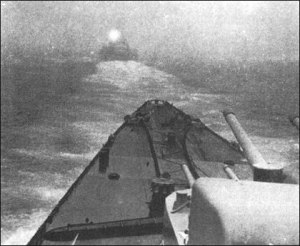
The Prinz Eugen follows Bismarck in the fog with the help of a searchlight. 22 May 1941.
http://en.wikipedia.org/wiki/HMS_Gloucester_%2862%29
http://en.wikipedia.org/wiki/HMS_Greyhound_%28H05%29
http://en.wikipedia.org/wiki/HMS_Fiji_%28C58%29
Ok homer ya finally hooked me to your posts,nice job
Your theory has merit. If you step back and look at the strategic importance Britain placed on the Bismarck threat, it seems they really were fearful of the damage the ship could do to convoys.
Note how just about every available ship has been thrown into the effort to stop Bismarck's mission. While Crete was a loss to British prestige, the Atlantic convoy's represented much greater strategic importance to Britain's survival.
This also reminds me of one of my favorite ‘what ifs’ of the war. What if Hitler had allocated more resources to U-boat construction instead of large surface ships. After all KM Bismarck DID NOT fulfill its mission of disrupting convoys. Suppose that instead of building that ship, the resources were put to constructing fifty (or ever how many) additional U-boats?
My friend William (RIP) parachuted into Crete (German army) among other places.
Just wait till a month from now, to the day, it should really pick up. Welcome.
Disclaimer: Opinions posted on Free Republic are those of the individual posters and do not necessarily represent the opinion of Free Republic or its management. All materials posted herein are protected by copyright law and the exemption for fair use of copyrighted works.